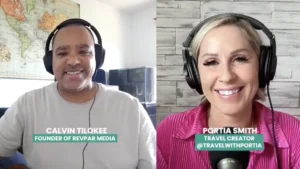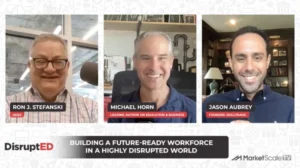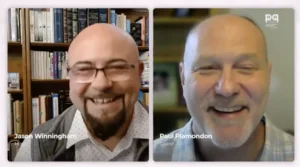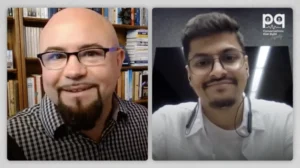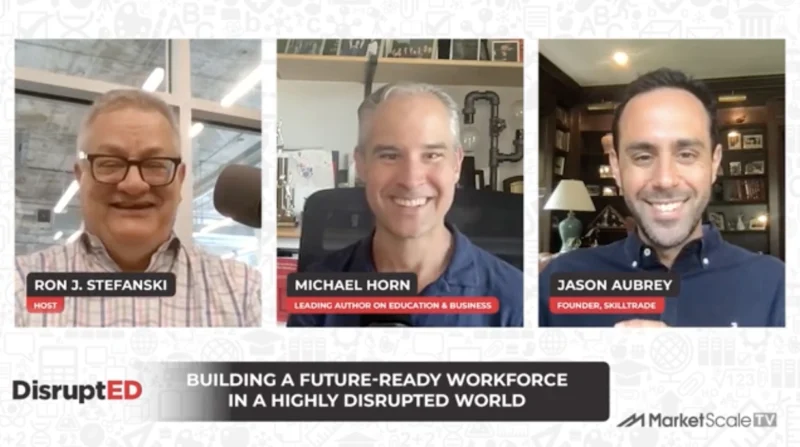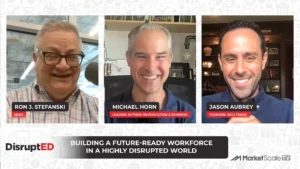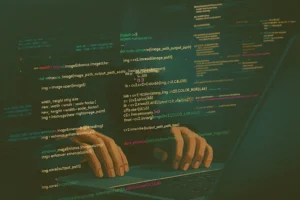How to Run an Accessible & Affordable Virtual Conference
Lisa Nielsen is Senior Director of Office of Digital Inclusion for the New York City Department of Education. Her post originally appeared on her personal site The Innovative Educator.
As a result of the Corona Virus Pandemic, we were faced with the choice of canceling our large yearly conference, or figuring out how to do a virtual conference. We opted for a virtual conference and decided to use Microsoft Teams and YouTube Live for our platform.
The Format
Traditionally, at our conferences we have opening remarks, a keynote speaker, vendor floor, workshops all day, and at the end we have closing remarks and awards. We kept some elements of the traditional conference, and scrapped or added others.
What we eliminated: Keynotes & workshops
On the chopping block were keynote speakers and workshops. Instead of a long-form, 45-minute keynote, we decided that short featured speakers and inspiring speakers would be better for an online format. We also eliminated workshops. This was because, once we moved online, we were providing dozens of workshops each day. Participants didn’t need a conference to access workshops.
What we kept: Vendor floor & awards
We kept the vendor floor, but had to figure out what it would look like were it to be virtual. We also decided to keep our traditional closing remarks and award ceremony, but with a twist. This year all staff received an award for their heroic efforts during our move to digital education.
What we added: Watch parties!
We added watch parties. This is because we knew that staff most wanted to connect and network with other like-minded individuals. We had more than a dozen watch parties grouped by affinity such as librarians, computer science teachers,special education teachers, or geographic location. In the watch parties, hosts were armed with a variety of interactive elements including polls, quizzes, discussion topics for each speaker, and more. Visit Tips for Hosting Watch Parties to learn more.
Tracks
Our first order of business was to determine what the focus of the conference would be this year. We wanted to address some of the biggest issues happening right now. We decided on the following tracks:
-
Equity
-
As we moved online it became more important than ever to address the digital divide. This means ensuring all students and staff had access to the technology that would result in effective teaching and learning
-
-
Digital Citizenship
-
As nearly all content moves online, it is of utmost importance that every educator takes on the role of understanding digital citizenship for themselves and their students.
-
-
Diversity
-
In our school community more than 50% of families speak a language other than english at home. This means we want to create content that is appropriate for the diversity represented among staff, students, and families.
-
-
Digital Accessibility
-
Approximately 20% of our students have a disability. It is imperative that staff understands and knows how to create content that is accessible to all.
-
Speakers
We brought in featured speakers to represent the areas we wanted to address at our conference, however, we also wanted to bring in other voices. This included the staff that often connected with our audience such as those who provided professional development opportunities. We also brought in the voices of students, educators, and families.
The Platforms
We chose platforms our district already had available. This enabled us to run a virtual conference without having to purchase an expensive technology.
YouTube Live
We choose YouTube Live as our platform for several reasons.
-
Unlimited audience
-
Automatic Closed Captioning after the event that can be edited if there are errors
-
Moderated commenting for an interactive experience
Microsoft Teams
We selected Microsoft Teams for our watch parties and vendor floor.
Vendor Floor
We created a vendor floor that launched during the conference, but would be available afterwards for ongoing support. We created a “Digital Education Partners” Team with dozens of vendors. Each vendor had their own channel. We encouraged vendors to add videos to their feed that showed teachers and students using their platform. We also encouraged them to add files and tabs that included things like contact information, link to their website, purchasing information. We also encouraged them to set up a live meeting where participants can drop in, have a chat, and learn more.
Watch Parties
We set up a meeting in each themed channel, for the watch parties. In each channel participants had the ability to interact in many ways.
-
Chat
-
During the watch party participants can respond to what they are seeing in the chat. The chat also has interactive elements including:
-
Reactions: Participants could react to what was happening in the chat with emojis and gifs.
-
Feelings: For any comment, participants can respond with a thumbs up, heart, sad face, angry face, laugh, or surprise.
-
-
-
Video and voice
-
The host can invite participants to come off mute and engage in conversation with voice or voice and video. Multiple participants can speak at a time.
-
If need be, the host can mute or remove participant.
-
-
Polls
-
In the channel, the host can create polls using Polly or forms for increased interactivity and engagement.
-
Accessibility
One of the benefits of Microsoft Teams is that participants can select closed captioning during meetings. We also had a sign language interpreter available for anyone who needed those services.
The Hashtag
We also provided an interactive experience by encouraging folks to use the hashtag #NYCSchoolsTech to share what they were learning in social media. Social media was abuzz with information and our hashtag even trended on Twitter.
The Summit Video
Below is the post-video of the live-streamed event enjoyed during the watch parties.


